Intel’s Sandy Bridge i7-2820QM: Upheaval in the Mobile Landscape
by Jarred Walton on January 3, 2011 12:00 AM EST- Posted in
- Laptops
- Intel
- Sandy Bridge
- Compal
Sandy Bridge Graphics: Extended Compatibility and Performance Results
It’s been quite a while since we last looked at gaming compatibility and performance on a large group of titles, so we figured the timing was ripe with the Sandy Bridge launch. We went through and selected fourteen additional games from the past several years; the intention is to see if SNB can run the games properly, as well as what sort of performance it can provide.
For comparison, we selected four other notebooks that we had on hand, which we’ve already highlighted on the previous page. Dell’s Latitude E6410 represents the old guard Intel HD Graphics, and the Toshiba A660D (forced onto the integrated HD 4250 GPU) is AMD’s soon-to-be-replaced IGP. Both are slower than SNB by a large amount, as we’ve already established. On the higher performance side of the equation, we’ve again got the Acer 5551G with a Turion II P520 (2.3GHz dual-core) processor and HD 5650 GPU, and for NVIDIA we have the ASUS N53JF with i5-460M and GT 425M. We tested Low and Medium detail performance, again skipping the Dell and Toshiba systems for Medium.
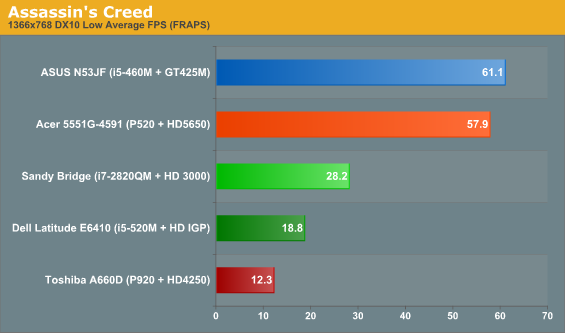
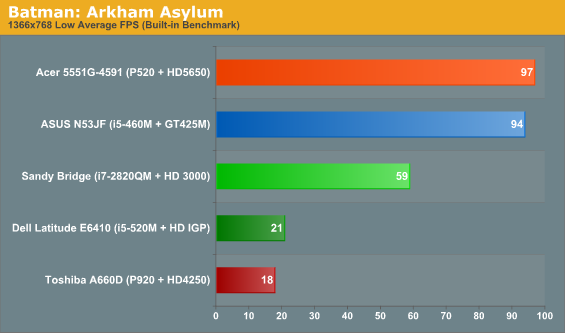
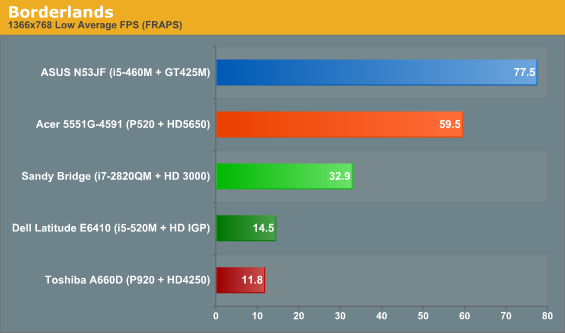
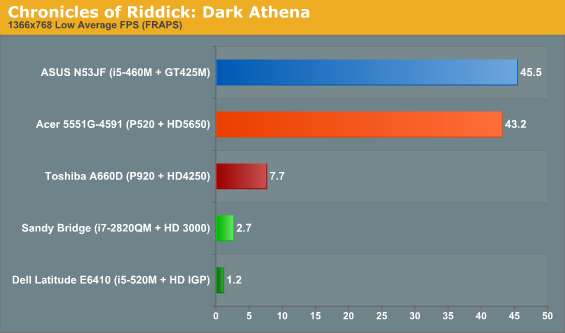
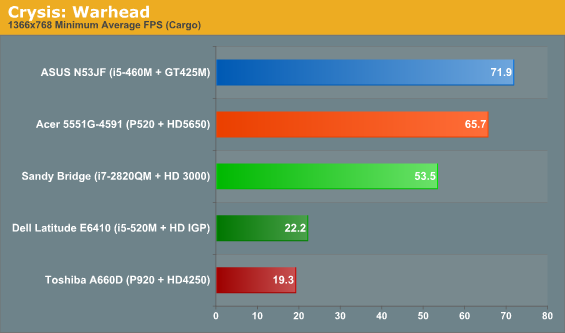

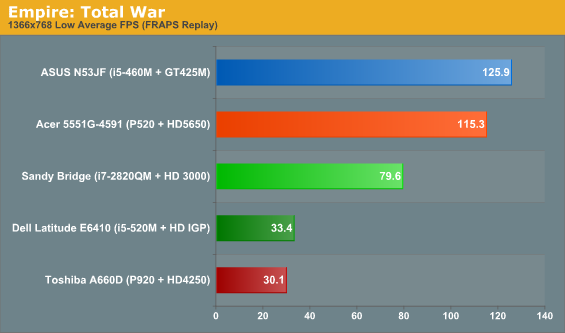
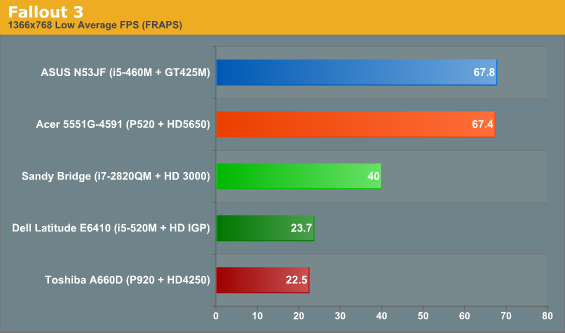
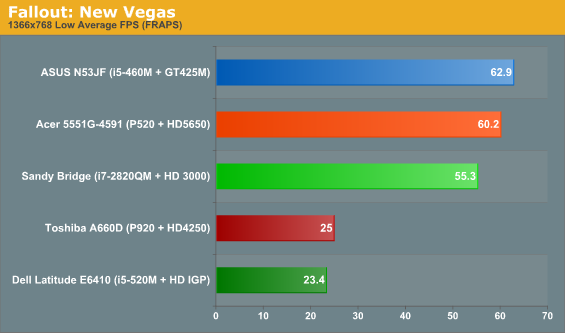
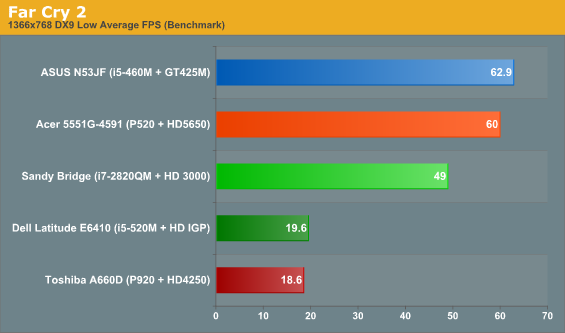
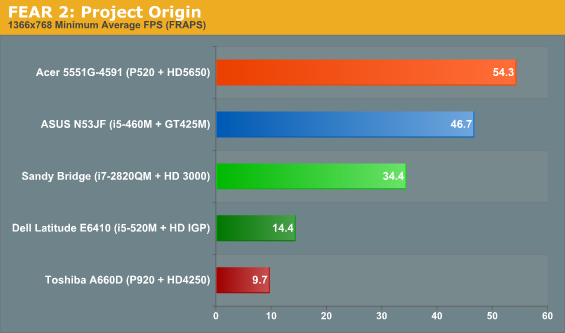

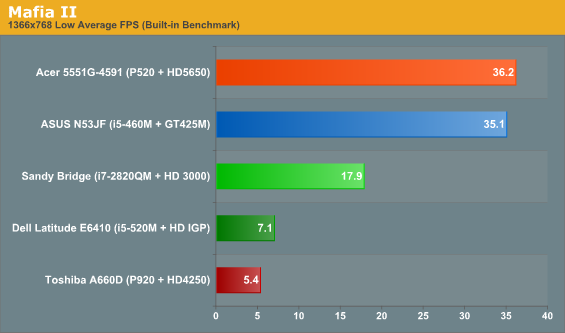
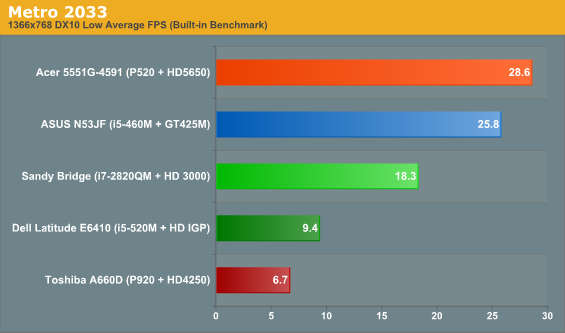
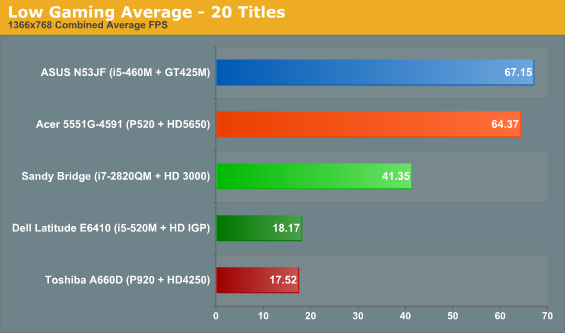
Adding 14 additional titles to the mix exposes a few more areas where Intel’s HD Graphics 3000 chip needs some fine tuning, but again all titles managed to at least run (with a bit of elbow grease). The problem areas run the range of blacklisted titles to minor rendering flaws (sometimes major flaws on older Intel graphics), with one title running but doing so poorly that it may as well have failed the test.
Going into details, first up is the now-infamous Fallout 3, which required a hacked D3D9.dll file to even run (just put the file in the game’s directory—thanks to the creators at OldBlivion). The hacked DLL identifies Intel graphics as a GeForce 7900 GS; without the DLL, the game crashes to the desktop with an error message as soon as you try to enter the actual game world. (Also note that the newer Fallout: New Vegas has no such problems, so Ubisoft was kind enough to stop blacklisting Intel’s IGPs it appears.) There are almost certainly other titles where the Intel IGP is blacklisted, and more than a few games warned of an unknown GPU and potential rendering problems (HAWX 2, Mass Effect 2 and Metro 2033, for instance), but only FO3 required a hack to actually run.
Besides the above, there were some other issues. Assassin’s Creed and HAWX 2 had occasionally flickering polygons, and Mafia II had some rendering issues with shadows; both are minor glitches that don’t render the games unplayable, but in the case of Mafia II performance is too low to be manageable. Finally, the one title from our list that has clear problems with Intel’s current drivers is Chronicles of Riddick: Dark Athena. It’s interesting to note that this is the sole OpenGL title in our suite, and it checks in at a dismal <3FPS. The older Intel HD Graphics on Arrandale has the same issues as HD 3000, with the additional problem of seriously broken rendering in HAWX 2.
Outside of the above problems, performance is typically high enough to handle minimum to medium detail levels. Average frame rates on Sandy Bridge across the 20 test titles ends up at 41FPS. That works out to a 128% improvement over the previous Intel HD Graphics, and a 136% lead over AMD’s HD 4250. The HD 5650 with a slower CPU still leads by over 55%, and GT 425M likewise maintains a comfortable lead of 62%; that said, you can certainly make the case that mainstream gaming is easily achievable with Sandy Bridge. Finally, it’s worth noting that while AMD’s HD 4250 actually ends up slightly slower than the old Intel HD Graphics on average, we didn’t encounter a single noticeable rendering error with that GPU in our test suite.
There are three exceptions to “playability” in our list, counting Dark Athena: both Mafia II and Metro 2033 fail to get above 30FPS, regardless of setting—though Mafia II comes close at 29FPS when set to 800x600. These two titles are a familiar refrain, and it’s worth noting that many discrete mobile GPUs also fail to reach playable performance; in fact, Dark Athena also tends to be a bit too much for anything lower than an HD 5650/GT 420M. They’re the modern equivalent of Crysis, except you can’t even turn down setting enough (without hacking configuration files) to make them run acceptably.










66 Comments
View All Comments
tipoo - Monday, January 3, 2011 - link
Sorry if I missed this somewhere in the review, but does the graphics component support OpenCL?RyuDeshi - Monday, January 3, 2011 - link
Second to last paragraph on the "Extended compatibility and performance results:""Ultimately, Sandy Bridge’s IGP is far more capable than many would have expected. Sure, it doesn’t even try to support DX11 or OpenCL, but at least for gaming DX11 is typically too much for even midrange GPUs."
CharonPDX - Monday, January 3, 2011 - link
An Intel rep has said that Sandy Bridge will support OpenCL. (http://news.cnet.com/8301-13924_3-20024079-64.html ) The trick is that it may be a combo CPU+GPU to do it. So it may not be what you are thinking by OpenCL being solely GPU, but OpenCL code should be able to run.And in the end, what does it matter, really, as long as it runs? As the desktop Sandy Bridge review points out, video encoding is just as fast using solely the x86 codepaths as using nVidia's CUDA or ATI's Stream.
Voldenuit - Monday, January 3, 2011 - link
OpenCL was designed from the outset to run on heterogenous resources, including CPU.So intel claiming that they "support" OpenCL is nothing special - they just needed the right drivers/API.
However, don't expect OpenCL code running solely on the CPU (my guess as to how SB will handle it) to be any faster than the x86 codepath running on the same CPU.
Checkbox feature.
jameskatt - Monday, January 3, 2011 - link
What Intel wants to do is to have the CPU run OpenCL code.This totally defeats the purpose of OpenCL.
OpenCL is suppose to allow both the GPU and the CPU to run code simultaneously. This is to allow significant acceleration in running OpenCL code compared to using just the CPU.
Sure. OpenCL code will run. But it will run MORE SLOWLY than with a discrete GPU. And the 16 GPUs in Sandy Bridge will be wasted.
Intel's Sandy Bridge has non-programmable GPUs. This is a serious limitation and deal killer when it comes to running OpenCL code.
I expect Apple to continue use nVidia's or AMD's discrete GPUs with the MacBooks and Mac Book Pros.
This is very disappointing. It shows that Intel still doesn't have the talent to produce decent GPUs.
PlasmaBomb - Monday, January 3, 2011 - link
*cough* I think you mean 12 EU *cough*
Guspaz - Monday, January 3, 2011 - link
<i>What Intel wants to do is to have the CPU run OpenCL code.This totally defeats the purpose of OpenCL.
OpenCL is suppose to allow both the GPU and the CPU to run code simultaneously. This is to allow significant acceleration in running OpenCL code compared to using just the CPU.</i>
No, this is the *primary* purpose of OpenCL. The goal of OpenCL is not to "allow the GPU and CPU to run code simultaneously", but to provide a single unified code path that can be used with any hardware, be it CPU or GPU. There are/were already code paths specific to each vendor/type (CUDA for nVIDIA GPUs, Stream for AMD/ATI GPUs, x86 for Intel/AMD CPUs). The problem is that fully supporting all three platforms requires three separate code paths.
OpenCL unifies this, and allows a single codepath to be used regardless of the GPU's type or existence. You've completely misunderstood the purpose of OpenCL.
Wiggy McShades - Tuesday, January 4, 2011 - link
You need to ask what applications on a desktop actually use OpenCL in a meaningful way? Intel added hardware for media transcoding, which makes transcoding on something besides the cpu useless and that was roughly all openCL can be used for on the desktop, laptop, or cellphone.OpenCL is for vector calculations, AVX is for vector calculations. All four cores running AVX instructions would just be a faster choice than OpenCL on a low end gpu. Intel most likely could get sandybridge's gpu running OpenCL, but it would be pointless. OpenCL just is not a desktop feature.
strikeback03 - Wednesday, January 5, 2011 - link
Given how much money they have, I doubt Intel is lacking the "talent" to do anything they want. OpenCL execution on the GPU portion of the SNB chips was probably just not that big a deal to them, and given the number of other things (such as speed and battery life) SNB brings to the table they probably won't have trouble selling lots of these to the average consumer.8steve8 - Monday, January 3, 2011 - link
which mobile cpus on pg1 support TXT or VT-d or AES-NI or VT-x or Quick Sync?